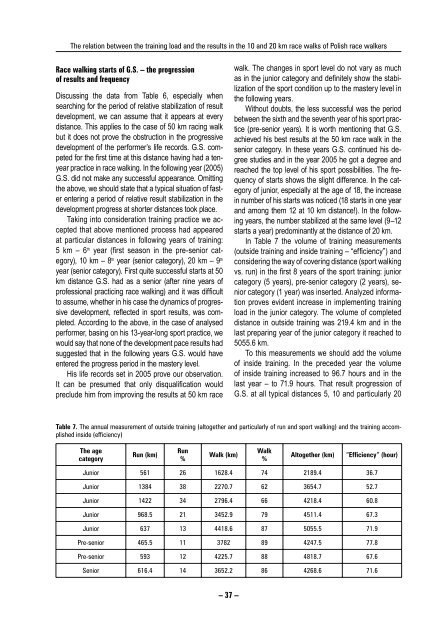Antropomotoryka nr 51 - Akademia Wychowania Fizycznego w ...
Antropomotoryka nr 51 - Akademia Wychowania Fizycznego w ...
Antropomotoryka nr 51 - Akademia Wychowania Fizycznego w ...
- No tags were found...
You also want an ePaper? Increase the reach of your titles
YUMPU automatically turns print PDFs into web optimized ePapers that Google loves.
The relation between the training load and the results in the 10 and 20 km race walks of Polish race walkersRace walking starts of G.S. – the progressionof results and frequencyDiscussing the data from Table 6, especially whensearching for the period of relative stabilization of resultdevelopment, we can assume that it appears at everydistance. This applies to the case of 50 km racing walkbut it does not prove the obstruction in the progressivedevelopment of the performer’s life records. G.S. competedfor the first time at this distance having had a tenyearpractice in race walking. In the following year (2005)G.S. did not make any successful appearance. Omittingthe above, we should state that a typical situation of fasterentering a period of relative result stabilization in thedevelopment progress at shorter distances took place.Taking into consideration training practice we acceptedthat above mentioned process had appearedat particular distances in following years of training:5 km – 6 th year (first season in the pre-senior category),10 km – 8 th year (senior category), 20 km – 9 thyear (senior category). First quite successful starts at 50km distance G.S. had as a senior (after nine years ofprofessional practicing race walking) and it was difficultto assume, whether in his case the dynamics of progressivedevelopment, reflected in sport results, was completed.According to the above, in the case of analysedperformer, basing on his 13-year-long sport practice, wewould say that none of the development pace results hadsuggested that in the following years G.S. would haveentered the progress period in the mastery level.His life records set in 2005 prove our observation.It can be presumed that only disqualification wouldpreclude him from improving the results at 50 km racewalk. The changes in sport level do not vary as muchas in the junior category and definitely show the stabilizationof the sport condition up to the mastery level inthe following years.Without doubts, the less successful was the periodbetween the sixth and the seventh year of his sport practice(pre-senior years). It is worth mentioning that G.S.achieved his best results at the 50 km race walk in thesenior category. In these years G.S. continued his degreestudies and in the year 2005 he got a degree andreached the top level of his sport possibilities. The frequencyof starts shows the slight difference. In the categoryof junior, especially at the age of 18, the increasein number of his starts was noticed (18 starts in one yearand among them 12 at 10 km distance!). In the followingyears, the number stabilized at the same level (9–12starts a year) predominantly at the distance of 20 km.In Table 7 the volume of training measurements(outside training and inside training – “efficiency”) andconsidering the way of covering distance (sport walkingvs. run) in the first 8 years of the sport training: juniorcategory (5 years), pre-senior category (2 years), seniorcategory (1 year) was inserted. Analyzed informationproves evident increase in implementing trainingload in the junior category. The volume of completeddistance in outside training was 219.4 km and in thelast preparing year of the junior category it reached to5055.6 km.To this measurements we should add the volumeof inside training. In the preceded year the volumeof inside training increased to 96.7 hours and in thelast year – to 71.9 hours. That result progression ofG.S. at all typical distances 5, 10 and particularly 20Table 7. The annual measurement of outside training (altogether and particularly of run and sport walking) and the training accomplishedinside (efficiency)The agecategoryRun (km)Run%Walk (km)Walk%Altogether (km)“Efficiency” (hour)Junior 561 26 1628.4 74 2189.4 36.7Junior 1384 38 2270.7 62 3654.7 52.7Junior 1422 34 2796.4 66 4218.4 60.8Junior 968.5 21 3452.9 79 4<strong>51</strong>1.4 67.3Junior 637 13 4418.6 87 5055.5 71.9Pre-senior 465.5 11 3782 89 4247.5 77.8Pre-senior 593 12 4225.7 88 4818.7 67.6Senior 616.4 14 3652.2 86 4268.6 71.6– 37 –





![Antropomotoryka nr 57 [2012]. - Akademia Wychowania Fizycznego ...](https://img.yumpu.com/50213388/1/182x260/antropomotoryka-nr-57-2012-akademia-wychowania-fizycznego-.jpg?quality=85)










